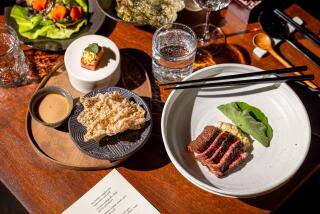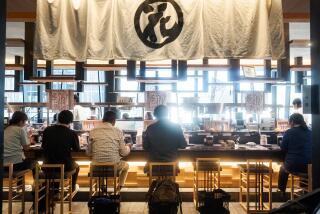American Iron
- Share via
Only three American chefs have ever been called to Japan to do battle on “Iron Chef.” The most recent American to pick up the gauntlet was Ron Siegel of San Francisco’s highly regarded Charles Nob Hill restaurant. Siegel, 32, a veteran of Restaurant Daniel in New York and the French Laundry in Napa Valley, had never heard of “Iron Chef” when the show’s creator, Toshihiko Matsuo, selected him to appear.
Although challengers occasionally triumph, the incredible time pressure, combined with the unfamiliar kitchen, gives the Iron Chefs a huge home court advantage. But Siegel was forewarned that the surprise theme ingredient would be either chestnuts, salmon, acorn squash or lobster, so he developed a menu that could work with any of them. “I was going to do a soup, salad, pasta and an entree no matter what, and a custard if it was lobster,” Siegel says.
Then Siegel flew to Japan. After two days of practice with a pair of sous chefs who didn’t speak English, he thought he was ready. But when he arrived at the studio for the taping, the “Iron Chef” staff refused to let him bring in anything except two stocks he had prepared. Everything else he’d planned to use was confiscated, according to the rules of the show.
“ ‘This is ridiculous,’ ” Siegel says he thought at the time. “ ‘I can’t speak Japanese. They wouldn’t let me bring in my stuff.’ But I thought. ‘I’m still going to do it.’ ”
A third of the way into the battle, however, he hadn’t finished a single dish. Matuso figured the American challenger didn’t have a chance.
“The time goes very fast,” Siegel says. “I thought I was doomed. After 20 minutes they were all in the studio control room thinking I was never going to finish. They told me if I failed, they would have canceled the show and lost a million bucks!”
One of the challenges of “Iron Chef” is cooking with one, two and three cameras, sometimes only inches from one’s face. “There was a point when I started swearing and the cameraman just wouldn’t back off,” Siegel recalls. “The cable would get caught around my leg and I had to push him away.” The only word of Japanese Siegel picked up on the set was “doku” (get out of the way).
For Siegel, the show began inauspiciously. A huge tank of live lobsters rose out of the floor presenting Siegel and Hiroyuki Sakai, the Iron Chef of French cuisine, with their theme ingredient. Once host Kaga gave the command, “Start cooking, gentlemen!” they literally ran across the set to select their lobsters.
Racing back with a tray of live lobsters, Siegel got tangled in a television cable that stripped off his shoe. Such mishaps, like crashes at an auto race, are part of the thrill of watching “Iron Chef.” Rice cookers break, food processors fly out of control, sorbets freeze stiff in ice cream machines, tin cans must occasionally be attacked with a hammer and screwdriver. Many a hurrying chef has severely lacerated a finger on the show.
Siegel quickly recovered his shoe and turned out a sumptuous five-course lobster dinner that the judges unanimously preferred over Iron Chef Sakai’s. Now Siegel’s San Francisco restaurant can expect to be inundated by Japanese tourists eager to sample the cuisine of the first American to emerge victorious on “Iron Chef.”
More to Read
Eat your way across L.A.
Get our weekly Tasting Notes newsletter for reviews, news and more.
You may occasionally receive promotional content from the Los Angeles Times.










